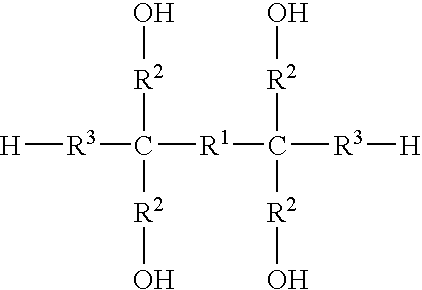Process for making stable cured poly(glycidyl nitrate) and energetic compositions comprising same
a technology of glycidyl nitrate and polymer, which is applied in the field of making stable cured poly (glycidyl nitrate) and energetic compositions comprising same, can solve the problems of reducing the energetic performance, affecting the widespread use of pgn as a binder, and inherently de-cures of conventional cured pgn, so as to reduce the formation of cyclic oligomers, reduce the formation of monomers
- Summary
- Abstract
- Description
- Claims
- Application Information
AI Technical Summary
Benefits of technology
Problems solved by technology
Method used
Image
Examples
example 1
Preparation of Glycidyl Nitrate
In a one-liter three-neck round bottom flask equipped with a magnetic stirrer, thermometer, additional funnel, and nitrogen sparge line was placed 140 grams of glycerine diluted with an equal volume of methylene chloride. The flask was immersed in a cooling bath. 300 ml of nitric acid (90%) was added while maintaining the temperature of the solution below 25° C. The mixture was allowed to stand with a vigorous nitrogen sparge for 4 to 18 hours. After 1 hour, the isomeric mixture of 1,2-dinitroglycerin and 1,3-dinitroglycerin accounted for 36.3 molar percent of the mixture. This amount of isomeric mixture of dinitroglycerin increased to 39.0 molar percent after 2 hours, 44.5 molar percent after 4 hours, 71.5 molar percent after 5 hours, and 73.8 molar percent after 6 hours. 50 percent sodium hydroxide was then added while cooling to maintain the temperature of the mixture below 25° C. After the mixture was determined to be neutral, additional solid sodi...
example 2
Preparation of Glycidyl Nitrate
In a 300 milliter three-neck round bottom flask equipped with a magnetic stirrer, thermometer, additional funnel, and nitrogen sparge line was placed 70 grams of glycerine (0.76 mole) diluted with 50 ml of methylene chloride. The flask was immersed in a cooling bath and cooled to 5° C. 150 ml of nitric acid (90%) was added drop wise over a 30-45 minute period and then stirred at room temperature for 5 to 6 hours. 30% NaOH solution was then added to the nitrated glycerol solution while cooling to maintain the temperature of the mixture below 25° C. After the mixture was determined to have a pH of 14, additional 30% NaOH solution in an amount of 275 grams was added slowly to maintain the temperature below 25° C. The mixture was allowed to stand for about 0.5 hours, then extracted three times with ether. The organic phases were combined, dried with magnesium sulfate, filtered, and evaporated in vacuo, providing approximately 44 grams of pure glycidyl nitr...
example 3
Preparation of Glycidyl Nitrate
92 grams of glycerine and 100 ml of methylene chloride were stirred at 0° C. with air bubbling into the reaction mixture and 280 grams of nitric acid added drop wise over 2.5 hours. After addition, the reaction was cooled to −4° C. and left for 16 hours. After this time a solution of 104 grams of sodium hydroxide in 269 ml of water was added, keeping the reaction temperature at 0° C. until the mixture was neutral. At this point, stirring was stopped and two phases separated. The aqueous phase was removed and the colorless organic phase was weighed (128 grams), and shown by nmr to be more than 90 percent purity dinitroglycerine with small amounts of trinitroglycerine, methylene chloride and mononitroglycerine. The organic phase was mixed with 65 ml of methylene chloride and an additional 282 grams of 30 percent sodium hydroxide was added over 20 minutes, keeping the reaction at 20-25° C. After addition, the reaction was stirred for an additional 10 minu...
PUM
| Property | Measurement | Unit |
|---|---|---|
| weight percent | aaaaa | aaaaa |
| weight percent | aaaaa | aaaaa |
| weight percent | aaaaa | aaaaa |
Abstract
Description
Claims
Application Information
 Login to View More
Login to View More - R&D
- Intellectual Property
- Life Sciences
- Materials
- Tech Scout
- Unparalleled Data Quality
- Higher Quality Content
- 60% Fewer Hallucinations
Browse by: Latest US Patents, China's latest patents, Technical Efficacy Thesaurus, Application Domain, Technology Topic, Popular Technical Reports.
© 2025 PatSnap. All rights reserved.Legal|Privacy policy|Modern Slavery Act Transparency Statement|Sitemap|About US| Contact US: help@patsnap.com


